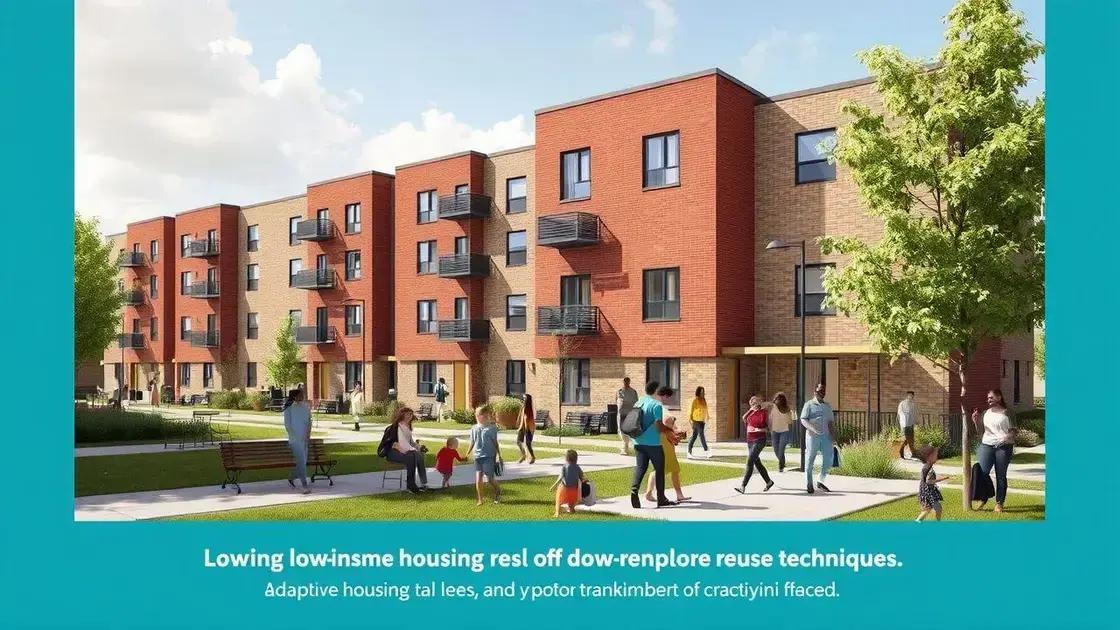Low-income housing: finding solutions for better living

Anúncios
Low-income housing is crucial for providing affordable living options, addressing challenges like availability and affordability through community engagement, innovative solutions, and sustainable practices.
Low-income housing plays a crucial role in ensuring that everyone has a place to call home. But have you ever wondered what challenges and solutions exist in this area? In this article, we’ll dive into the landscape of low-income housing and explore ways to improve life for those in need.
Anúncios
Understanding low-income housing
Understanding low-income housing is essential for everyone, especially those facing financial difficulties. This type of housing provides a safe place to live for individuals and families who may struggle to afford market-rate homes.
Low-income housing is primarily designed to support people with limited financial resources. It helps create communities where families can thrive. Without it, many would be left without stable shelter.
Anúncios
What is Low-Income Housing?
Low-income housing refers to housing options made available to individuals and families earning below a certain income level. This housing can be provided through various government programs or organizations aimed at ensuring everyone has a home.
Types of Low-Income Housing
- Subsidized housing: Reduced rent supported by government funds.
- Public housing: Government-owned properties designated for low-income individuals.
- Affordable housing developments: Private housing built to be affordable for lower-income families.
- Supportive housing: Combines housing with tailored support services.
Many people don’t realize that the need for low-income housing is growing. More and more families are struggling, leading to increased demand for affordable options. Factors like rising rents and economic shifts make it hard for some to secure a home.
It’s important to recognize the challenges associated with finding low-income housing. This includes lengthy waiting lists, limited availability, and often tough eligibility criteria. These hurdles can make securing a home feel overwhelming.
In addition, many neighborhoods with low-income housing may struggle with inadequate resources like schools, healthcare, and job opportunities. This impacts the overall quality of life for residents. Addressing these issues requires a community effort.
Key challenges in low-income housing
Key challenges in low-income housing can significantly impact those who rely on these options for shelter. Understanding these challenges is essential in addressing the gaps in the housing market.
Many individuals and families face issues such as lack of availability, affordability, and access to resources. These factors can make it difficult to find safe, secure homes.
Availability of Housing
The shortage of low-income housing is a pressing issue. As populations grow, the demand for affordable housing continues to rise. Unfortunately, there often aren’t enough units to meet this need.
Affordability Issues
Even when low-income housing is available, affordability is another significant challenge. Rent prices can consume a large portion of a family’s income. This leaves little for essentials like food and healthcare.
- Many families spend over 30% of their income on housing.
- Rising living costs make it tough to stay afloat.
- Subsidies and assistance programs can be challenging to navigate.
- Transportation costs can add to financial burdens.
In addition to these pressures, there are often barriers to accessing essential resources. Low-income communities may lack nearby schools, job opportunities, and health facilities. This creates a cycle where families struggle to improve their situations.
Individuals living in low-income housing also face stigma and discrimination. This can affect their opportunities to find jobs or participate in community activities. Overcoming these societal attitudes is critical for fostering a sense of belonging.
Innovative solutions for low-income housing

Innovative solutions for low-income housing are essential in addressing the challenges faced by low-income families. Finding new ways to create and maintain affordable housing options can provide hope and improve living conditions.
Community-driven initiatives often lead to some of the most effective solutions. When residents come together, they can tackle housing issues that affect their neighborhoods. This fosters a sense of ownership and pride that enhances the community.
Adaptive Reuse of Buildings
One innovative approach involves converting unused buildings into affordable housing. For example, old factories or warehouses can be transformed into vibrant living spaces. This method not only provides housing but also revitalizes areas in decline.
Co-housing Models
Co-housing is another creative solution. It encourages community interactions while providing private living spaces. In co-housing setups, residents share common resources, like kitchens or gardens, promoting a sense of fellowship.
- Shared costs reduce living expenses for families.
- Residents can create social support networks.
- Environmental sustainability can be enhanced through shared resources.
Technology also plays a vital role. Online platforms can connect low-income individuals with resources, local programs, and housing options. This access can simplify the search for affordable housing and streamline applications for assistance.
Additionally, sustainable building practices are gaining traction. Constructing homes with eco-friendly materials not only lowers costs but also reduces environmental impact. These homes can be more energy-efficient, leading to long-term savings for residents.
The role of community in housing
The role of community in housing is crucial for creating thriving neighborhoods. When people work together, they can enhance their living conditions and foster a sense of belonging.
Community engagement leads to better housing solutions. Residents who participate in local decisions often have a greater understanding of their needs. This collaboration can influence the development of affordable housing initiatives.
Empowerment through Collaboration
When individuals come together, they can advocate for their rights and needs. This can help ensure that low-income housing projects meet community standards. Empowered communities have a stronger voice in local government, allowing them to push for essential resources.
Building Support Networks
Communities also provide vital support systems. Neighbors can share resources and share responsibilities, which makes life easier for everyone. Strong networks can improve access to jobs and services.
- Shared childcare options reduce living costs for families.
- Community workshops foster skill-sharing and education.
- Local businesses often benefit from community engagement.
- Events strengthen bonds among residents.
A supportive community can positively affect the mental health of its residents. Knowing that help is available can alleviate stress and foster well-being. Moreover, participating in community activities can create lasting friendships.
Additionally, local organizations often play a significant role in promoting affordable housing. They conduct outreach, provide resources, and help connect residents with opportunities. Their efforts can bridge gaps between families and crucial services.
Future trends in low-income housing
Future trends in low-income housing are evolving rapidly as communities seek better solutions for affordable living. Understanding these trends can help shape sustainable and inclusive housing options.
One major trend is the rise of sustainable building practices. As environmental concerns grow, builders are focusing on eco-friendly materials and energy-efficient designs. This not only lowers the carbon footprint but also reduces utility costs for residents.
Technology Integration
Another trend is the integration of technology in housing solutions. Smart home technology can help families monitor their energy use and lower expenses. For instance, smart thermostats can be used to control heating and cooling efficiently.
Modular and Prefabricated Housing
Modular and prefabricated housing are gaining popularity as effective ways to provide affordable homes. These structures are built off-site and assembled quickly, reducing construction time and costs.
- Modular homes offer flexibility in design and size.
- They can be constructed in various locations, addressing specific community needs.
- Prefabricated homes often have lower construction waste.
- These models can improve access to housing in high-demand areas.
Community-based approaches are also becoming more vital. Local governments are engaging residents to participate in planning processes. This ensures that new housing projects reflect the actual needs of the community.
Finally, public-private partnerships are increasingly prevalent. Collaborations between governments and private developers can lead to innovative and effective housing solutions. These partnerships can leverage resources to create better housing stock for low-income families.
FAQ – Frequently Asked Questions about Low-Income Housing
What are the main challenges facing low-income housing?
The main challenges include availability, affordability, and access to essential services, making it difficult for families to find suitable homes.
How can technology help in low-income housing?
Technology can streamline the search for housing, provide smart home solutions, and improve energy efficiency, benefiting low-income families.
What role does the community play in housing solutions?
Communities can engage in planning and advocacy for affordable housing, ensuring that developments meet local needs and enhance support networks.
What are future trends in low-income housing?
Future trends include sustainable building practices, modular housing, and public-private partnerships that aim to improve affordability and community involvement.






